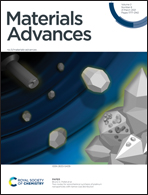Achieving ultra-narrow bandgap non-halogenated non-fullerene acceptors via vinylene π-bridges for efficient organic solar cells†
Abstract
The field of organic solar cells (OSCs) has witnessed rapid progress in the last two years, due to the emergence of high-performance Y-series non-fullerene acceptors (NFAs). To further extend this family of the Y-series NFAs and tune their optoelectronic properties, herein, we developed a family of the Y-series NFAs (namely BTP-1V, BTP-2V, BTP-3V, and BTP-4V) by inserting vinylene π-bridges between the Y-series central fused core and non-halogenated end group IC. The incorporation of vinylene π-bridges can effectively reduce the bandgap of these NFAs with a significantly red-shifted absorption edge approaching 1020 nm. The optimized OSC device based on PBDB-T/BTP-1V demonstrated an excellent power conversion efficiency (PCE) of 11.03% with an open-circuit voltage (Voc) of 0.84 V, a short-circuit current density of 20.86 mA cm−2, a fill factor of 0.63, and an energy loss of 0.58 eV. It is worth noting that the PCE of over 11% is the highest value for binary single-junction OSCs based on the non-halogenated NFA with a bandgap below 1.28 eV. These results demonstrate that the vinylene π-bridges strategy strongly regulates the optoelectronic characteristics of NFAs, offering insights into the development of efficient OSCs based on ultra-narrow bandgap Y-series NFAs.



 Please wait while we load your content...
Please wait while we load your content...